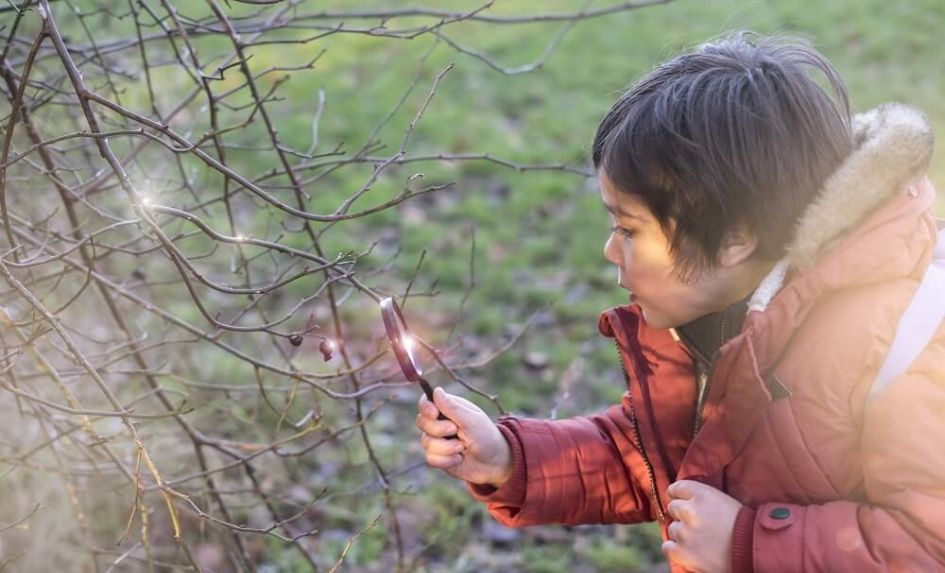The benefits of being outside to both physical and mental health have been much discussed during the pandemic. As a result, outdoor learning has been in the limelight.
Of course, the benefits of being outside to children’s minds and bodies, as well as to their knowledge and understanding is an age-old piece of education wisdom.
But how can schools plan and manage an increase in outdoor learning while coping with bubbles, one-way systems and the vagaries of the British winter weather?
Start with what you have
Every school has a different outdoor area. Yours is unique to your school and will have its own quirks and bonuses. Set up an Outdoor Learning Team to focus on the learning that can happen outside at your school – be sure that this team, however small, represents teaching and support staff.
The team will need to reflect on the space you have available. Questions to ask:
- How muddy do grassy spaces get in winter?
- How can a concrete play area be used to support nature-based learning?
- How do different outside zones need to be organised?
- How will the number and movement of ‘bubbles’ influence the way we manage our outdoor learning opportunities?
- What resources do we already have that can be adapted for use to enhance learning outside?
Ask the Outdoor Learning Team to carry out an audit of the available equipment and how it can be used for learning in different subjects: for example, how can the slide or climbing frame be used beyond sliding and climbing? Can it be a help teach a lesson about measurement or gravity or provide inspiration for creative writing?
Transitions
Movement from inside to outside and back again can involve a lot of faffing, particularly in the winter. All those damp coats, the escaping hats and gloves, the muddy shoes, the steamy corridors.
However, transitions between places inside and outside the school are likely to be tightly managed under pandemic conditions. Children may now store their outdoor clothing in their classrooms or have been encouraged to become more independent at putting on coats, hats and gloves. This increased focus on transition spaces and times can make it easier to manage groups of children as they move in and out.
However, it’s important that new rules and processes are introduced to teachers and children with care.
Does everyone know how it works? Perhaps children from different classes could make a short video about how to move around the school and where things go – because the staff team need some help remembering!
Timetabling
Good transitions and a successful use of available space requires careful timetabling. Depending on the layout and size of your school, both inside and outside, it may not be appropriate to have multiple classes all having outdoor learning experiences at the same time. If you have created an Outdoor Learning Team, ask them to liaise with class teachers to find a time for outdoor learning for every class.
Can they build in flexibility to cater for unpredictable situations? Or for those spontaneous moments when a teacher notices the learning that is happening inside could be explored at greater depth using opportunities only offered by being outside? This will require some give and take!
What does outdoor learning mean to your school?
Outdoor learning is not about doing what you do inside and just relocating it outside. It is about recognising and utilising the unique learning opportunities the outside offers and building those into your curriculum.
This requires commitment and understanding from the whole school community. Does outdoor learning feature on the School Development Plan? What stage are the staff team at with their understanding, knowledge, and feelings about outdoor learning? Some adults just don’t like being outside. And lots of us use ‘bad weather’ language: stormy days are ‘grim’, rain is ‘wet and miserable’. Have fun as a team turning this around and talking more positively about different kinds of weather – especially with the children.
Make time for the Outdoor Learning Team to run staff meetings to share experiences and training and for everyone to contribute thoughts and ideas. Remember to make these inclusive of teachers and support staff so that everyone is on board.
Bring in the Early Years team
Whether you have Reception and Nursery classes, or Reception only, you will have Early Years staff who know about outdoor learning. They understand the logistics and can help with the practical considerations as you develop a wider provision for all children.
They can also share their experience of using outdoor learning to make links between aspects of the curriculum with teachers in other key stages.
Communicate with families
As always, communication with parents and carers is key. From a purely practical point of view, in the winter children are going to need access to waterproofs, wellies and warm clothes to be able to spend periods of time learning outside. Are there funds to purchase waterproof trousers and to keep spare items for children who may struggle to have these things? How can you share with parents what outdoor learning is going to look like at your school and why it is important for their children?
Current pandemic restrictions may mean you are already finding different ways to reach parents, and so a video clip (made by children with help from the Outdoor Learning Team?) or a blog post, letter or email home can be a start. Follow ups of pictures or short clips of children learning outside will keep the momentum going. Enhancing the outdoor learning in your school could be a positive way to turn current challenges into future opportunities.
Juliet Mickelburgh is Education Adviser at Tapestry, the online learning journal, and a former primary school teacher. She also writes for the Foundation Stage Forum. Ideas for this article are also viewable on Tapestry’s outdoor learning activity infographic here.









